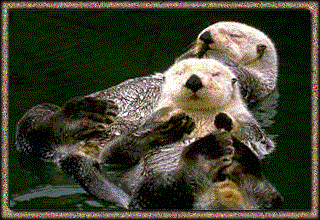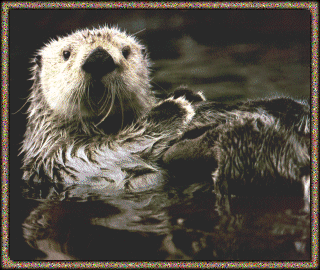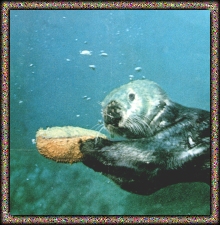 
The sea otter (Enhydra lutris) is native to limited areas off the coast of Alaska and northern California. It is 4 to 6 feet long as an adult. Usually weighing 33 to 66 pounds, but may reach 100 pounds. They breed at around 4 years of age, resulting in a single pup born 6 to 8 months later. The female sea otter gives birth every 2 to 3 years. She remains inseparable from the youngster for up to a year, carrying the baby on her chest while she floats, and on her back when she swims. Baby sea otters are born at sea with their eyes wide open and ready to swim, since the sea otter is exclusively marine, rarely ever coming to shore. 
Sea otters lounge off the coast by mooring themselves by wrapping strands of seaweed around their bodies to nap. Mothers often leave their young cradled on the kelp while diving for food. Sea otters have jaws that can crush the shells of mussels, snails, crabs, sea urchins, and abalone. They also use rocks brought up from the sea bed to crush the shells of their food. All the while floating on their backs. They may eat up to a fifth of their body weight per day. 
They rely on 2 things to keep warm in the frigid water since they have no blubber. One is keeping well groomed so that their thick fur traps air and keeps them warm and buoyant. Two is their high metabolic rate, keeping them eating and grooming throughout the day. Their lifespan is 15 to 20 years for both sexes. Their face color tends to lighten with age. The sea otter once populated the shores of the northern Pacific Ocean from Japan to Alaska to lower California. Almost hunted to extinction for their fur. An international treaty was enacted in 1911 to protect them. The treaty was signed by the United States, Great Britain, Russia, and Japan to stop the killing. Surviving colonies slowly began to multiply. 
They have an impact on the ecology of the cold shores to the point that marine biologists call them a keystone species. By eating sea urchins, they help maintain the balance of life in the extensive kelp forests off the coast of California. The purple sea urchin, whose population dramatically increased during the period the sea otter was overhunted, feeds on the kelp plant. Thick acres of kelp forest, which provide habitats for millions of animals, were reduced to marine deserts by a combination of sea urchins and increasing pollution from coastal development. Many marine biologists believe that the return of the sea otter has helped save these productive ecosystems. 
References

Site Map Ocean Dreams Email at: dh @ naturehaven.com (Take out the spaces and this email address will work!) Please Read Guestbook ~~~ Please Sign Guestbook  |